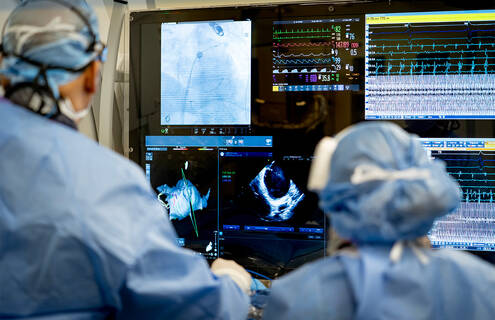
Atrial fibrillation is on the increase. But if you or a loved one are among the estimated 2.7 to 6.1 million people in the United States with the condition, a groundbreaking treatment is now available.
The new method, pulsed field ablation (PFA), has been shown to treat some forms of atrial fibrillation with good effect. It has faster procedure times than conventional techniques and carries less risk to the heart’s adjacent structures, making a generally safe procedure potentially even safer.
“It's exciting to be able to provide this approach for our patients," says Rajbir Sangha, MD, who is on the team now offering PFA at Dartmouth Hitchcock Medical Center’s Heart and Vascular Center. “It is one of many treatment options now available to help us treat what is becoming an increasingly common condition."
“This technology has been in the works for a decade, but it only recently became commercially available in the U.S. We are fortunate to be among the first hospitals across the country to have PFA as an option to offer to our patients,” says Kevin Kwaku, MD, PhD, Director of Cardiac Electrophysiology at Dartmouth Hitchcock Medical Center's Heart and Vascular Center.

What is AFib
The introduction of Pulsed Field Ablation for the treatment of atrial fibrillation, also known as AFib, comes at a crucial time.
Atrial fibrillation is now the most common type of abnormal heart rhythm. Researchers estimate that U.S. cases will reach 12.1 million by 2030.
“Some patients describe that it can feel like a fish flopping or a butterfly flapping its wings in your heart,” says Sangha. “But not always. Sometimes people don’t feel atrial fibrillation happening at all, or have more subtle symptoms such as fatigue or shortness of breath.”
The number of adults developing AFib increases with older age, but it can appear at any age. Recent studies even show a growing number of elite athletes in their twenties with the condition.
Some factors can make you more prone to the condition. These risk factors include:
- High blood pressure
- Underlying heart disease
- Excess weight
- Drinking alcohol
- Sleep apnea
- Family history
- Other chronic conditions such as hyperthyroidism, diabetes, asthma, and other chronic medical problems
“To have the best chance of maintaining normal rhythm, it is critical for patients to work on managing their modifiable risk factors,” Kwaku emphasizes.
What happens when a heart goes into AFib
Normally, a heart’s beat is initiated by pacemaker cells located in the sinus node of the right atrium, or right-upper heart chamber. Every time those cells fire, the sinus node produces an electrical signal that causes both atria (upper chambers) to contract. The signal then flows through the atrioventricular node into the ventricles (lower chambers) to make them contract.
Unlike a heart attack, which stems from a blockage impeding blood flow in a coronary artery, atrial fibrillation is an electrical problem. When a heart goes into atrial fibrillation, the electrical signals in the heart’s upper chambers become chaotic, leading the lower chambers to contract often rapidly, and always, irregularly. It’s both the rapidity and irregularity of the heart rate that can lead to significant symptoms, impacting quality of life.
AFib is often placed in one of three categories. In paroxysmal atrial fibrillation, episodes start and stop on their own. Patients who experience it may be younger and they often have noticeable symptoms like dizziness, chest pain, shortness of breath, and fatigue.
In persistent atrial fibrillation, the episode is continuous and the heart must be shocked back into normal rhythm (a procedure called cardioversion).
Over time, permanent atrial fibrillation can develop and the heart cannot be brought back to normal rhythm.
Not everyone needs treatment for AFib
Treatment is not always necessary.
The heart’s misfires can be relatively inconsequential for some, especially when the fibrillation lasts for short periods and is able to return to a regular heartbeat on its own.
However, atrial fibrillation can lead to an increased risk of blood clots that can block blood flow to the brain and lead to a stroke.
The Centers for Disease Control and Prevention (CDC) points to research that shows that atrial fibrillation causes one in seven strokes in the United States. Because of this risk, anticoagulants or blood thinners are an important part of therapy for many patients with AFib.
What treatments exist?
Patients decide with their doctors whether and how to treat their AFib based on their diagnosis, symptom burden, and other factors.
Possible treatments include anti-arrhythmic medications; non-invasive but temporary procedures like cardioversion; and minimally invasive catheter ablation procedures, which diminish the heart’s propensity to go into AFib.
More rarely, more invasive approaches such as a pacemaker or other forms of surgery may be indicated.
Ablation
Studies show that in around 70 to 80 percent of cases, a single ablation procedure helps significantly reduce atrial fibrillation and its symptoms.
Thermal ablation for AFib involves inserting a flexible catheter into a blood vessel and feeding it into the heart, where hot or cold temperatures typically target the area around the pulmonary veins entering the left atrium.
“Technology has evolved rapidly over the last few years and now PFA offers improved safety when compared to thermal ablation,” says Sangha.
PFA involves electroporation, which is the delivery of rapid, high-voltage pulsed electrical fields to the heart tissue. “Think of it as a discharge of static electricity—it packs a punch without generating much heat,” says Kwaku. This results in a lower risk of damage to surrounding non-cardiac structures.
Whether the treatment is right for you or your loved one will be determined by your doctor after a clear diagnosis of AFib is made. That diagnosis likely comes after an ECG, or ambulatory monitor, and an in-depth evaluation of your symptoms and risk factors.
If you don’t need treatment
Everyone can take measures to protect their heart. Frequently recommended lifestyle changes include:
- Regular physical activity
- A heart-healthy diet low in salt, saturated fats, trans fats and cholesterol
- Managing high blood pressure
- Avoiding excessive amounts of alcohol
- Not smoking
- Controlling your cholesterol
- Maintaining a healthy weight
- Diagnosing and treating Sleep apnea
So what should you do if you have been diagnosed with AFib?
The cardiology subspecialty that manages heart rhythm disorders is called electrophysiology. If you have been diagnosed with AFib and have symptoms, ask to see a cardiac electrophysiologist to learn what options may be right for you.